
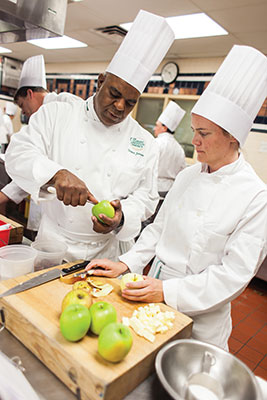
By Brack Johnson
I have always loved food.
One of my earliest memories is of my grandmother pulling an iron skillet out of the oven to reveal golden corn bread, then splitting the cakey squares in half and slathering on fresh butter until it oozed over the sides.
We'd often drive from Durham to her West Virginia home. No matter when we arrived, Grandma sat my little brother and me down in her warm kitchen and whipped up yummy plates: corn bread or just-picked veggies or turnovers bursting with fruit from her garden.
Like my grandmother, I'm a self-taught cook – pretty good at the things I know how to make, fairly intuitive about the rest.
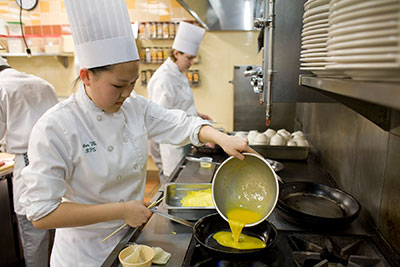
I'd never taken a cooking class until last month, when I attended a five-day boot camp at the Culinary Institute of America, the country's premier college for chefs. The jam-packed days of learning, cooking, eating and drinking made for more than just an inspired vacation. They changed what I can do to feed my family and myself.
The main campus of the school, which awards bachelor's and associate's degrees, is in the Hudson River Valley town of Hyde Park, N.Y. The "CIA" includes almost 50 professionally equipped kitchens and bakeshops.
The college has trained a cornucopia of famous talents who're known for their restaurants, cookbooks and TV appearances. Celebrity alumni include John Besh, Anthony Bourdain, Cat Cora, Rocco DiSpirito, Amanda Freitag, Sara Moulton, Charlie Palmer, Michael Symon, Roy Yamaguchi and Geoffrey Zakarian.
Want to know what it's like to step inside the kitchens of the CIA? Here's a taste of boot camp, which ran each day from about 2 to 8 p.m., as well as recipes we used to make some of the most mouthwatering stuff I've ever eaten.
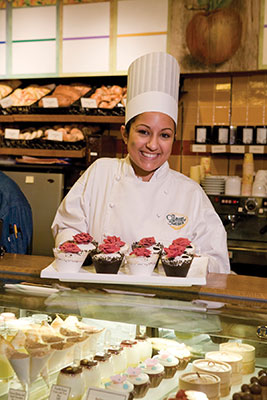
MONDAY
The campus is filled with students wearing their chef's whites. The moment I put on my uniform, I feel transformed from a maker of decent Sunday brunches to an honest-to-goodness chef.
The 13 cooking enthusiasts who're taking the hands-on course with me are excited and a little nervous. We've come from as far as Colorado and as close as New York City.
Jessica, a staff sergeant and military chef about to deploy to Germany, is enrolled by the U.S. Marines. Vivian, from Florida, is living out a dream from her bucket list. Joanne and Steven, a couple from Pennsylvania, are celebrating their anniversary.
Such a diverse class, but we all share one thing: a desire to become masters of our own kitchens.
Chef Stephen Johnson (no relation to this writer), a seasoned instructor, puts us at ease with his welcoming attitude. Johnson trained at the Culinary Institute, worked for more than a decade as a top-flight executive chef and returned to the campus 13 years ago.
Although an uber expert in seafood, Johnson is a chef of all trades. Under his tutelage, it seems clear, no dish is beyond our reach. By the end of the first hour, we shorten his name, with due respect, to "Chef."
The typical day at boot camp starts in a culinary classroom as Chef lectures with a booming smile and soft Texan drawl. Then, we move into a huge kitchen, where he demonstrates the key skills we'll be using to prepare the day's dishes.
We're broken into four groups, each of which has its own distinctive menu to prepare at a station fully equipped to prep and cook.
Chef patiently guides us, tossing out magic from his bag of tricks. He occasionally calls for all the boot campers to come over and watch him display a step-by-step technique. For example, we gather round the team making an Italian dinner as he demonstrates how to use a pasta machine and shape potato gnocchi.
When the cooking is complete, we fill our plates from the grand assortment crafted by all four teams and sit down to a gourmet dinner accompanied by a few glasses of wine, a soupcon of exhaustion and a ton of pride.
Finally, we return to the test kitchen. One member of each group presents her team's offerings. Chef lobs softball questions. ("How were you able to cut the baklava so the filo dough didn't get crushed?") He gently reviews the fine points while critiquing and encouraging us.
-
The first day is a bit different from the rest because we aren't actually cooking a finished meal. But we come away with basic principles, such as menu planning, ingredient selection and workspace organization. The essentials include:
- Garnishes, plating and presentation ("Chef: First, you eat with your eyes.");
- Mise en place (This means organization, including having all the ingredients out and measured before starting to cook.);
- Fundamentals ("Burnt is burnt - there's no fixing burnt.");
- Stocks (Whether it's beef, chicken, seafood or vegetable, this broth is the basis for soups, sauces and all manner of good stuff.); and
- Knife skills ("The No. 1 tool in the kitchen is a quality knife.")
Given the importance placed on knife skills, all our time in the kitchen today is spent on cutting up the seasonal bounty. Under the watchful eye of Chef and four student assistants, we slice onions, julienne carrots, dice celery, mince garlic, chop parsley, peel kiwis and wedge apples.
The student assistants take the result of our day's work and quickly turn it into tempting fare. Like peas in a pod, we sit down to a rustic dinner, the atmosphere electric with camaraderie as we engage in foodie discussions.
It's a stress-free, 10-minute drive to my home for the week, the Hampton Inn & Suites in Poughkeepsie. Spotting my uniform as I walk into the motel, the friendly front-desk clerk calls out, "Good evening, Chef," and I smile.
I take a dip in the spacious indoor pool and melt into the hot tub. Then, I drop into bed and sleep like a baby...a baby dreaming of cutting boards.
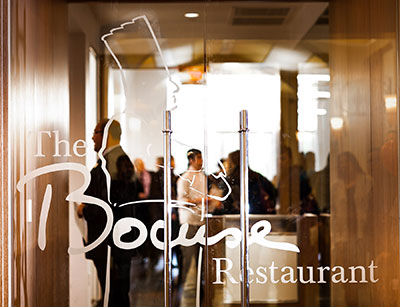
TUESDAY
The class meets early for a tour of the campus and lunch at one of its four haute-cuisine restaurants, in which both the front and back of the house is staffed by students.
Bocuse, a dramatic French eatery with an open kitchen, focuses on innovative variations of the classics, such as wild salmon gravlax with mint cream and brioche toast. I indulge in black truffle soup topped with puff pastry and pan-seared scallops with crisp chorizo sausage.
There are no words to adequately capture dessert, but I'll do my best. White coffee ice cream profiterole is prepared tableside with the use of liquid nitrogen. It's accompanied by small treats, including smoked chocolate sauce, caramelized cocoa nibs, petite French pastries, green tea pound cake and blueberry compote, rhubarb and strawberry soup, and warm cherry tart.
Although Bocuse is fine dining at its finest, somehow the venue manages to avoid being pretentious or stuffy. Maybe it's the eager students, who seem passionate about what they're doing – even offering tours of the kitchen.

Back in the classroom, Chef lectures on sautéing, stir frying, pan frying and deep frying as well as coatings, thickening agents and sauces.
He then explains how to pound meats, make a silky beurre blanc (butter sauce), form handcrafted spaetzle (egg noodles), produce racks of lamb and bread everything. ("Keep one hand wet and one dry.")
The skillets start sizzling, and the air is filled with irresistible aromas as we begin to work with flavors from different regions of the world.
My group, Team One, prepares a delicious Bavarian-inspired bill of fare starting with endive, apple and fennel salad topped with warm apple cider-bacon vinaigrette. Our menu also features wiener schnitzel with lemon-caper beurre blanc, braised red cabbage and spaetzle.
Team Two invites us to mangia with zesty eats, such as potato gnocchi and sautéed pork cutlets with wild mushroom ragout.
Team Three does up some of North Carolina's favorites, and they do it proud: B.L.T. salad with buttermilk-chive dressing, fried chicken with country gravy, glazed carrots, and macaroni and cheese with bacon.
Team Four turns out a tasty Louisiana supper straight from Bourbon Street. It's chopped steakhouse salad with crumbled Maytag blue cheese and red wine vinaigrette, fried catfish (recipe follows), okra stewed with tomatoes (recipe follows) and Creole dirty rice.
Fried Catfish
Yield: 6 portions
Vegetable oil (for frying) as needed
1-1/2 lb. Catfish fillets, boneless, skinless
2 cups Cornmeal
1 cup All-purpose flour
1 Tbsp. Salt
1 tsp. Old Bay seasoning
1/2 tsp. Garlic powder
1/2 tsp. Onion powder
1/4 tsp. Ground black pepper
6 Lemon wedges
1. Preheat a fryer to 350 degrees or fill a medium soup pot about 1/2 full with vegetable oil and heat to 350 degrees.
2. Cut each catfish fillet into quarters and reserve in the refrigerator.
3. In a mixing bowl, combine the cornmeal, flour, salt, Old Bay, garlic powder, onion powder and black pepper.
4. Dredge (coat) the catfish pieces in the seasoned cornmeal.
5. Deep fry the catfish until golden brown and crisp, about 4 to 5 minutes.
6. Drain on paper towels.
7. Serve immediately on a heated platter with lemon wedges on the side.
Source: The Culinary Institute of America © 2013
Okra Stewed With Tomatoes
Yield: 6 portions
1-1/2 lb. Okra, whole, fresh or frozen
3 Bacon strips, diced
1-1/2 cups Onions, julienne
1/2 cup Chicken stock
3 - 4 Tomatoes, peeled seeded and chopped
Salt to taste
Ground black pepper to taste
1. Rinse the okra, trim away the caps and slice about 1/2-inch thick. Reserve.
2. Place the bacon in a skillet over medium heat and sauté, stirring occasionally, until the fat has rendered and the bacon is crisp.
3. Add the onions to the skillet and sauté, stirring occasionally, until golden brown, 12 to 15 minutes.
4. Add the okra, stock and tomatoes, and stir to combine. Cover the skillet and reduce the heat to low. Simmer, stirring occasionally, until the okra is tender and cooked through, about 15 minutes.
5. Season with salt and pepper to taste.
6. Serve in a heated bowl.
Source: The Culinary Institute of America © 2013
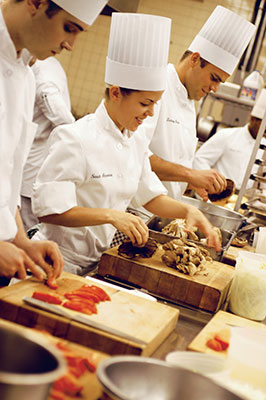
WEDNESDAY
Chef teaches about soups (clear broths, creamy purees, chunky gumbos, rich chowders), broiling, roasting and baking plus the flavor development and seasoning involved in marinades, brines and rubs.
Using a whole salmon, he explains how to choose a good one and how to fillet it. ("If your fishmonger won't let you smell it or touch it, go elsewhere.")
He also shows how to make a compound butter, truss poultry, create a fluffy pilaf, produce full-bodied pan gravy, showcase grill marks and temper (stabilize) ice cream.
My team reveals its grilling chops with salmon and orange-thyme butter, wild rice pilaf with dried cranberries, roasted corn succotash and seasonal fruit crisp.
Team Two's standard provisions become sophisticated bistro cuisine with roasted chicken and pan gravy, grilled zucchini, and buttermilk mashed potatoes.
Team Three is on fire with roasted pork loin and apricot-brandy compote, grilled ratatouille (recipe follows), creamy polenta (recipe follows) and vanilla ice cream.
Team Four takes the cake with lamb chops and lemon-parsley butter, garlic-roasted potatoes with parsley and oregano, Sicilian-style spinach and baklava.
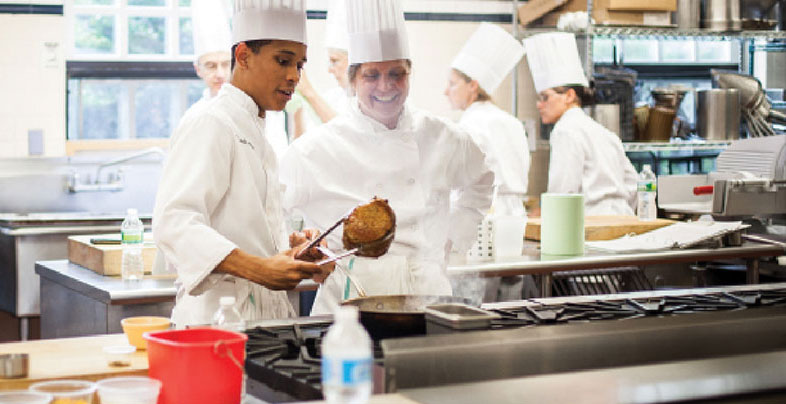
Grilled Ratatouille
Yield: 6-8 portions
1 Green bell pepper, quartered
1 Eggplant, cut into 1/2-inch slices
2 Zucchini, quartered lengthwise
2 cups White mushrooms, stems removed
4 Tomatoes, halved
1/2 cup Extra virgin olive oil
Salt to taste
Ground black pepper to taste
1 Red onion, small dice
1 Tbsp Garlic, minced
1 Tbsp Tomato paste
1/2 cup Chicken stock
1 Tbsp Oregano, chopped
1 Tbsp Thyme, chopped
2 tsp. Rosemary, chopped
1. Preheat a gas grill to medium heat. (If you're using a charcoal grill, build a fire and let it burn down until the coals are glowing red with a light coating of white ash. Spread the coals in an even bed. Clean the cooking grate.)
2. Lightly brush the pepper, eggplant, zucchini, mushrooms and tomatoes with about 1/4 cup of the oil and season with salt and pepper to taste.
3. Grill the vegetables until they have grill marks and are slightly charred and tender, about 5 to 10 minutes, depending on the vegetable. Remove from the grill and set aside until cool enough to handle. Roughly chop the vegetables.
4. Heat the remaining oil in a large pan over medium heat. Add the onions and sauté until translucent and just beginning to color, about 5 minutes. Add the garlic and sauté until fragrant, about 1 minute. Stir in the tomato paste and cook until it turns a deep color and gives off a sweet aroma, 1 to 2 minutes.
5. Add the grilled green pepper, zucchini, mushrooms, eggplant and tomatoes, in that order, allowing each to begin to soften before adding the next.
6. Add the stock, cover, and let the vegetables stew until completely tender, about 15 minutes. Add the fresh herbs, and adjust seasoning to taste with salt and pepper.
7. Serve on a heated platter.
Source: The Culinary Institute of America © 2013
Creamy Polenta
Yield: 6 portions
1-1/2 qt. Water
Salt as needed
2 cups Coarse yellow cornmeal
3 Tbsp. Butter
1/2 cup Parmesan cheese, grated
1 Tbsp. Flat-leaf parsley, chopped
Ground black pepper as needed
1. Bring the water to a boil and lightly season with salt.
2. Add the cornmeal in a stream, stirring constantly until it has all been added. Simmer, stirring often, until the polenta pulls away from the sides of the pan, about 30 minutes.
3. Remove the pot from the heat and stir in the butter, parmesan and parsley. Season to taste with salt and pepper.
4. Serve in a heated bowl.
Source: The Culinary Institute of America © 2013
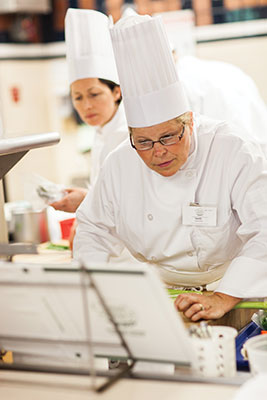
THURSDAY
It's our fourth day, and the teams are jelling like we've been working together for years. We know who likes to handle the protein and who loves to thicken sauces, who relishes taking risks and who enjoys mastering a challenge.
Today's lessons in gastronomy cover poaching, steaming, boiling, simmering, braising, stewing and cooking en papillote ("in paper").
Chef demonstrates how to form a strudel, make a risotto, shape pasta, whip up crème anglaise (known as "boiled custard" in the South) and poach just about anything.
My team makes simple-yet-elegant sage chicken, whipped sweet potatoes (recipe follows), roasted herbed root vegetables and bread pudding with rum crème anglaise (recipe follows).
"A recipe is just a guide," says Chef, so I use only a splash of rum, add a half cup of chocolate chips, and turn the custard into ice cream. Chef is right...improvising can work wonders!
Team Two offers a delectable wild mushroom and goat cheese strudel, hearty beef stew with butternut squash, braised Swiss chard and saffron risotto.
Team Three poaches a professional-quality red snapper Veracruz and pairs it with Mexican rice, drunken beans and stuffed poblano peppers.
Team Four impresses with fresh egg pasta, goat cheese croquettes and garlic chicken as well as green beans with bacon, shallots and mushrooms.
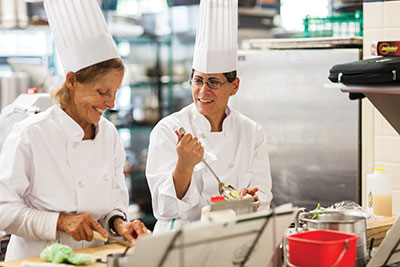
Whipped Sweet Potatoes
Yield: 6 portions
2-1/2 lb. Sweet potatoes, peeled, cut into large pieces
5 Tbsp. Butter, at room temperature
1/2 - 3/4 cup Milk, hot
Ground cinnamon to taste
Nutmeg, freshly grated to taste
Salt to taste
Ground black pepper to taste
1. Cook the potatoes in a large pot of boiling, salted water or steam until tender enough to mash easily, about 25 to 30 minutes. Drain and dry them over low heat or on a baking sheet in a 300-degree oven until no more steam rises from them. While the potatoes are still hot, purée them through a food mill or potato ricer into a heated bowl.
2. Add the butter and mix into the potatoes by hand or with the paddle or whip attachment of an electric mixer until just incorporated. Add the milk and combine thoroughly. Season with cinnamon, nutmeg, salt and pepper to taste, and whip by hand or with a mixer just until smooth and light.
3. Serve in a heated bowl.
Source: The Culinary Institute of America © 2013
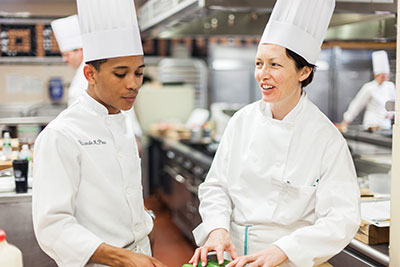
Bread Pudding With Rum Creme Anglaise
Yield: 6 portions
1 pt. Milk, hot
4 Eggs, beaten
2 Egg yolks, beaten
1/2 cup Sugar
1/4 tsp. Vanilla extract
3 cups Challah bread, preferably
l - 2 days old, cubed
1/2 cup Raisins
Butter (for greasing) as needed
1-1/2 cups Rum Creme Anglaise (recipe follows)
l. Preheat the oven to 325 degrees.
2. To prepare the custard, combine the milk, whole eggs, egg yolks, sugar and vanilla in a mixing bowl and whisk thoroughly.
3. Add the bread cubes and the raisins to the custard and gently mix to combine.
4. Butter six 4-fluid-ounce ramekins and fill to 1/4 inch below the rim with the pudding mixture. Place the filled ramekins in a baking dish large enough to accommodate the ramekins with moderate space in between. Prepare a water bath by carefully pouring very hot water into the baking dish until it reaches about halfway up the sides of the ramekins.
5. Bake at 325 degrees until the custard is slightly firm, about 30 minutes. Remove the baking dish from the oven, but allow the bread pudding to sit in the water bath for another 5 minutes.
6. Un-mold the puddings and serve on a heated platter with the Rum Crème Anglaise.
Source: The Culinary Institute of America © 2013
– – – Rum Crème Anglaise – – –
Yield: 1-1/2 cups
1 cup Milk
1/2 Vanilla bean
1/4 cup Sugar (divided use)
4 Egg yolks
1 Tbsp. Rum (or to taste)
1. Prepare an ice bath: place a clean stainless steel bowl inside a bowl of ice water. Set aside.
2. Combine the milk, vanilla bean and 2 tablespoons of sugar in a saucepan and bring to a boil over medium heat.
3. Meanwhile, prepare a liaison (thickening agent for the sauce) by blending the egg yolks with the remaining 2 tablespoons sugar in a mixing bowl.
4. Add half of the boiling cream mixture to the egg mixture and whisk well to blend. This process, known as tempering, will help slowly increase the temperature of the egg mixture so that the eggs do not coagulate and curdle when added to the boiling mixture.
5. Return the tempered egg mixture to the remaining hot cream mixture in the saucepan and continue cooking over low to medium heat, stirring constantly, until the mixture reaches 180 degrees and becomes nappé (the sauce will thicken enough to coat the back of the spoon).
6. Add the rum and stir to combine.
7. Remove immediately from the stove, strain the sauce through a fine-meshed sieve into a clean container, and cool quickly in an ice bath.
Variation: Vanilla extract may be substituted for vanilla bean in the amount of 1 tablespoon per vanilla bean.
Note: Sauce can be made over a water bath for more control of the heat source.
Source: The Culinary Institute of America © 2013
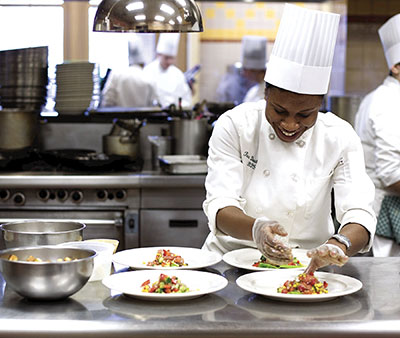
FRIDAY
Like the first four days, our last is all about cookery. But it's also about TV-inspired fun.
We start by competing as teams in a "Jeopardy" game of culinary knowledge. I realize I've learned so much this week!
Previously, my favorite phrase about my home meal prep was, "The kitchen looks like a bomb went off."
Now, I grasp the importance of organization. So, my No.1 saying is a quote from Chef: Before you even grab a spatula, "Cook it in your mind."
Next, it's on to Food Network's "Chopped." Unlike the TV contestants, we've had much more than a few minutes to plan. On the first day, each team was given its own list of ingredients. We've been strategizing all week to develop four courses using items from our market basket.
There are no wacky ingredients a la "Chopped." The contents of our baskets are items I'd find in a Harris Teeter in the Triangle.
My team gets shrimp, chicken breasts, white beans, sweet potatoes, wild mushrooms, green beans, red onions, cauliflower, sage, cheddar cheese, dried apricots and puff pastry.
Today, we employ our new-found comfort in the culinary arts to produce and plate dinners in three hours. Then, the class gathers to delight in the spread, engaging in a bit of back slapping for getting it all done.
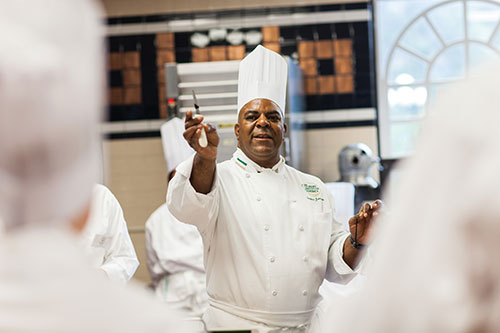
The buffet runs the gamut. One team tantalizes with New York steak loin, roasted asparagus and clam risotto with chorizo. Another tempts with cod cakes with lemon aioli, sugar snap peas with roasted red bell pepper and turnip mashed potatoes. My group shows off cauliflower cheddar soup, puff pastry filled with sautéed shrimp and curried sweet potatoes, white bean ragout, and apricot-glazed chicken with dried plums and sage.
As it turns out, we're all winners. The intensive instruction has deepened our understanding of food, upped our culinary know-how and boosted our confidence. We revel in seeing just how far we've gone beyond the basics in such a short time.
In a joyous ceremony, Chef calls each of our names, presents certificates and shakes hands. It feels as if we have, indeed, graduated to a whole new level.
After the smorgasboard is devoured, the wine quaffed and the coffee drained, we pack away our uniforms. All of us are looking forward to returning to our own kitchens to put our new skills into practice...and make Chef proud.
Photos by CIA / Phil Mansfield and Keith Ferris